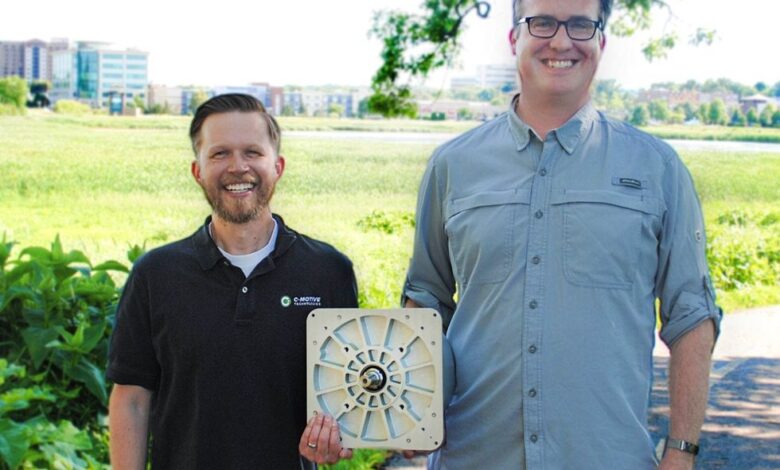Electrostatic Motors Reach the Macro Scale

It’s a pretty sure bet that you couldn’t get through a typical day without the direct support of dozens of electric motors. They’re in all of your appliances not powered by a hand crank, in the climate-control systems that keep you comfortable, and in the pumps, fans, and window controls of your car. And although there are many different kinds of electric motors, every single one of them, from the 200-kilowatt traction motor in your electric vehicle to the stepper motor in your quartz wristwatch, exploits the exact same physical phenomenon: electromagnetism.
For decades, however, engineers have been tantalized by the virtues of motors based on an entirely different principle: electrostatics. In some applications, these motors could offer an overall boost in efficiency ranging from 30 percent to close to 100 percent, according to experiment-based analysis. And, perhaps even better, they would use only cheap, plentiful materials, rather than the rare-earth elements, special steel alloys, and copious quantities of copper found in conventional motors.
“Electrification has its sustainability challenges,” notes Daniel Ludois, a professor of electrical engineering at the University of Wisconsin in Madison. But “an electrostatic motor doesn’t need windings, doesn’t need magnets, and it doesn’t need any of the critical materials that a conventional machine needs.”
Such advantages prompted Ludois to cofound a company, C-Motive Technologies, to build macro-scale electrostatic motors. “We make our machines out of aluminum and plastic or fiberglass,” he says. Their current prototype is capable of delivering torque as high as 18 newton meters and power at 360 watts (0.5 horsepower)—characteristics they claim are “the highest torque and power measurements for any rotating electrostatic machine.”
The results are reported in a paper, “Synchronous Electrostatic Machines for Direct Drive Industrial Applications,” to be presented at the 2024 IEEE Energy Conversion Congress and Exposition, which will be held from 20 to 24 October in Phoenix, Ariz. In the paper, Ludois and four colleagues describe an electrostatic machine they built, which they describe as the first such machine capable of “driving a load performing industrial work, in this case, a constant-pressure pump system.”
Making Electrostatic Motors Bigger
The machine, which is hundreds of times more powerful than any previous electrostatic motor, is “competitive with or superior to air-cooled magnetic machinery at the fractional [horsepower] scale,” the authors add. The global market for fractional horsepower motors is more than US $8.7 billion, according to consultancy Business Research Insights.
C-Motive’s 360-watt motor has a half dozen each of rotors and stators, shown in yellow in this cutaway illustration.C-Motive Technologies
Achieving macro scale wasn’t easy. Electrostatic motors have been available for years, but today, these are tiny units with power output measured in milliwatts. “Electrostatic motors are amazing once you get below about the millimeter scale, and they get better and better as they get smaller and smaller,” says Philip Krein, a professor of electrical engineering at the University of Illinois Urbana-Champaign. “There’s a crossover at which they are better than magnetic motors.” (Krein does not have any financial connection to C-Motive.)
For larger motors, however, the opposite is true. “At macro scale, electromagnetism wins, is the textbook answer,” notes Ludois. “Well, we’ve decided to challenge that wisdom.”
For this quest he and his team found inspiration in a lesser-known accomplishment of one of the United States’ founding fathers. “The fact is that Benjamin Franklin built and demonstrated a macroscopic electrostatic motor in 1747,” says Krein. “He actually used the motor as a rotisserie to grill a turkey on a riverbank in Philadelphia” (a fact unearthed by the late historian I. Bernard Cohen for his 1990 book Benjamin Franklin’s Science ).
Krein explains that the fundamental challenge in attempting to scale electrostatic motors to the macro world is energy density. “The energy density you can get in air at a reasonable scale with an electric-field system is much, much lower—many orders of magnitude lower—than the density you can get with an electromagnetic system.” Here the phrase “in air” refers to the volume within the motor, called the “air gap,” where the machine’s fields (magnetic for the conventional motor, electric for the electrostatic one) are deployed. It straddles the machine’s key components: the rotor and the stator.
Let’s unpack that. A conventional electric motor works because a rotating magnetic field, set up in a fixed structure called a stator, engages with the magnetic field of another structure called a rotor, causing that rotor to spin. The force involved is called the Lorentz force. But what makes an electrostatic machine go ‘round is an entirely different force, called the Coulomb force. This is the attractive or repulsive physical force between opposite or like electrical charges.
Overcoming the Air Gap Problem
C-Motive’s motor uses nonconductive rotor and stator disks on which have been deposited many thin, closely spaced conductors radiating outward from the disk’s center, like spokes in a bicycle wheel. Precisely timed electrostatic charges applied to these “spokes” create two waves of voltage, one in the stator and another in the rotor. The phase difference between the rotor and stator waves is timed and controlled to maximize the torque in the rotor caused by this sequence of attraction and repulsion among the spokes. To further wring as much torque as possible, the machine has half a dozen each of rotors and stators, alternating and stacked like compact discs on a spindle.
The 360-watt motor is hundreds of times more powerful than previous electrostatic motors, which have power output generally measured in milliwatts.C-Motive Technologies
The machine would be feeble if the dielectric between the charges was air. As a dielectric, air has low permittivity, meaning that an electric field in air can not store much energy. Air also has a relatively low breakdown field strength, meaning that air can support only a fairly weak electric field before it breaks down and conducts current in a blazing arc. So one of the team’s greatest challenges was producing a dielectric fluid that has a much higher permittivity and breakdown field strength than air, and that was also environmentally friendly and nontoxic. To minimize friction, this fluid also had to have very low viscosity, because the rotors would be spinning in it. A dielectric with high permittivity concentrates the electric field between oppositely charged electrodes, enabling greater energy to be stored in the space between them. After screening hundreds of candidates over several years, the C-Motive team succeeded in producing an organic liquid dielectric with low viscosity and a relative permittivity in the low 20s. For comparison, the relative permittivity of air is 1.
Another challenge was supplying the 2,000 volts their machine needs to operate. High voltages are necessary to create the intense electric fields between the rotors and stators. To precisely control these fields, C-Motive was able to take advantage of the availability of inexpensive and stupendously capable power electronics, according to Ludois. For their most recent motor, they developed a drive system based on readily available 4.5-kilovolt insulated-gate bipolar transistors, but the rate of advancement in power semiconductors means they have many attractive choices here, and will have even more in the near future.
Ludois reports that C-Motive is now testing a 750-watt (1 hp) motor in applications with potential customers. Their next machines will be in the range of 750 to 3,750 watts (1 to 5 hp), he adds. These will be powerful enough for an expanded range of applications in industrial automation, manufacturing, and heating, ventilating, and air conditioning.
It’s been a gratifying ride for Ludois. “For me, a point of creative pride is that my team and I are working on something radically different that, I hope, over the long term, will open up other avenues for other folks to contribute.”
IEEE Spectrum




